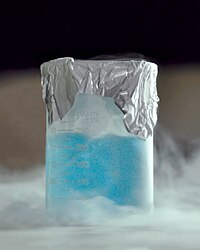
Photo from wikipedia
Abstract According to UN Test O.2, surprisingly, the polychlorosilanes hexachlorodisilane (HCDS), octachlorotrisilane (OCTS) and decachlorotetrasilane (DCTS) formally fulfill the criteria of the “test for oxidizing liquids”. This result is in… Click to show full abstract
Abstract According to UN Test O.2, surprisingly, the polychlorosilanes hexachlorodisilane (HCDS), octachlorotrisilane (OCTS) and decachlorotetrasilane (DCTS) formally fulfill the criteria of the “test for oxidizing liquids”. This result is in contrast to the properties of polychlorosilanes that are described in the literature and those we have experienced in our own production. By investigating the reaction products from the UN O.2 test reactor, using IR, Raman and XPS spectroscopy, it was shown that the results are not due to oxidizing properties of HCDS, OCTS or DCTS, but are caused by the specified test substance cellulose. To our knowledge, this is the very first substance class in which the reference substance oxidizes the test sample, instead of vice versa. This represents an important limitation of the internationally used UN Test O.2 for this substance class. The cause for this false-positive result is the known high degree of affinity of oxygen to silicon. It is shown that the correctly executed UN Test O.2 produces false-positive results and that the polychlorosilanes do not have an oxidizing effect and, therefore, do not have to be classified as “oxidizing substances”.
Journal Title: Journal of Loss Prevention in The Process Industries
Year Published: 2021
Link to full text (if available)
Share on Social Media: Sign Up to like & get
recommendations!